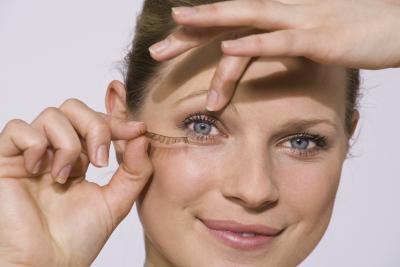Sparse eyelashes may be a cosmetic problem you can change with a little help from your doctor. Eyelash hypotrichosis, the term used to describe inadequate or not enough eyelashes, can be treated with a topical medication approved by the FDA. However, this medication, bimatoprost, can cause odd and even permanent side effects.
Bimatoprost History
Bimatoprost didn’t start as a cosmetic application. The FDA first approved it in 2001 as a prescription eye drop, marketed by the brand name Lumigan, to reduce intraocular pressure in patients with open-angle glaucoma or ocular hypertension. People who used Lumigan for medical purposes noticed increased eyelash growth as a side effect of their treatment. Allergan, a pharmaceutical company that focuses on creating eye products, developed bimatoprost solution 0.03 percent for topical use. The trade name for this medication is Latisse, which was approved by the FDA in December 2008.
Appropriate Use
To get the best results from Latisse, it must be used every day. It’s applied to the upper lash line only, not the lower eyelid. Start with clean skin, making sure to remove your make up and contact lenses first. Use the disposable applicator to apply the medication carefully, starting at the inner part of your eye and working outward. Use a tissue to blot excess solution that may accidentally find its way outside the treatment area.
Results
According to the manufacturer, you may see new lash growth in only 4 weeks; however, it takes 16 weeks for you to see optimal results. Eyelashes appear darker and fuller. You must continue to use Latisse to keep your lashes. If you stop using it, your lashes will revert to their former state.
Side Effects
Side effects of using topical bimatoprost include darkening of the skin along the lash line and dry, itchy red eyes. Most disturbingly, if you have pale eyes, your irises may permanently turn brown — this side effect is also noted in people who use Lumigan drops. Another curious and undesirable side effect of Latisse is that it can cause hair growth on the skin around your eyes if it drips or runs outside the treatment area.
Criticism
Latisse employs famous faces, such as actors Brooke Shields and Claire Danes, to market the eyelash treatment. In April 2010, Change.org writer Sarah Menkedick wrote that Latisse “signifies an all-time low for both the cosmetics and pharmaceutical industries” by implying that sparse eyelashes are a medical condition that requires treatment. As of 2011, the cost of Latisse is $120 every month, and it’s unlikely that your health insurance plan will cover the medication, Menkedick points out.
Other Tips
Latisse may not be the right treatment for you. It’s not effective in treating eyelash loss due to a medical condition called alopecia areata. Eyelash loss can also be caused by other medical conditions, such as blepharitis and lupus, as well as hair loss caused by chemotherapy treatments. Talk to your doctor to see if you’re an appropriate candidate for eyelash treatment using Latisse.





